- Italy Tours Home
- Italy Ethos
- Tours 2023
- Blog
- Contact Us
- Dolomites
- Top 10 Dolomites
- Veneto
- Dolomites Geology
- Dolomiti Bellunesi
- Cortina
- Cadore
- Belluno
- Cansiglio
- Carso
- Carnia
- Sauris
- Friuli
- Trentino
- Ethnographic Museums
- Monte Baldo
- South Tyrol
- Alta Pusteria
- Dobbiaco
- Emilia-Romagna
- Aosta Valley
- Cinque Terre
- Portofino
- Northern Apennines
- Southern Apennines
- Italian Botanical Gardens
- Padua Botanical Garden
- Orchids of Italy
Venzone: the Best Preserved Walled Medieval Town in Friuli.
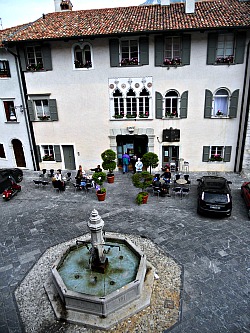
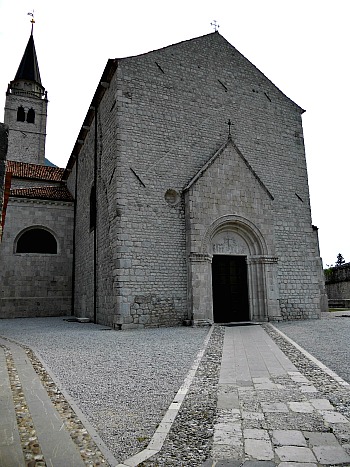
Venzone (in the first picture above, a picture of the harmonious main square) lies at the confluence of two important valleys, the Tagliamento valley that leads into Carnia and the Val Canale. Part of its territory is comprised within the natural park of the Julian Pre-Alps (“Parco Naturale delle Prealpi Giulie”), as this small walled town is situated right along the course of the Tagliamento, with the Carnian Alps (Alpi Carniche) to one side and the Julian Alps (Alpi Giulie) on the other.
Because of its favourable geographical position, Venzone has been a mandatory point since Celtic times (500 BC). The Romans, who came after the Celts, made it one of their stations along the “Via Julia Augusta Altinate” – an important thoroughfare linking Altino (along the Adriatic coast near Venice) to the Northern European markets through Aquileia, at the time the most important centre in Friuli.
A number of different archaeological discoveries came to light due to the excavations carried out during the restoration of the Duomo – the town’s most notable monument (portrayed in the second picture above) – and these have confirmed the existence of a Roman building in the vicinity.
Venzone: A Very Interesting History
Throughout the following centuries, the area was successfully invaded by the Guards, the Marcomanns, the Visigoths, the Huns, the Ostrogoths, the Byzantines, the Langobards and the Carolingians. The first urban township dates back to this latter period (776-952 AD), when the name of Venzone starts to be mentioned.
The toponym ‘Venzone’ is cited from the first time in 923 as ‘Clausas de Albiciones’, and it derives – in all likelihood – from a root ‘av-au’, ‘flusslauf’ (spring, water course) – a clear reference to running water, which is abundant in the area, and that could refer to the Venzonassa stream. Officially, however, the town is first cited only in 1001, on a diploma from Emperor Otto III, in which the use of the ‘erbatico’ of the Canal del Ferro is given to the Patriarch of Aquileia (this term designated a wide expanse of grass, held of great value at the time – as opposed to the flatlands of Friuli, which were then still largely covered in woodland and marshes).
In 1077 the town became part of the Patriarchate of Aquileia, with an important role controlling the passage of the commercial traffic. In 1258, the Patriarchs of Aquileia gave it as a fiefdom to Glizoio di Mels, a member of the Mels family, who became lord of the area and increased its prestige, and in 1247 allowed it to be recognized as a legal municipality. This also gave rise to a wealthy market, which was further strengthened in the 14th century. It was at this time that the double circle of walls were constructed: eight metres high, and 1,5 metres wide, their plant was hexagonal with unequal sides; they were strongly anchored by a system of 15 towers, and surrounded by a deep moat in which water from the stream could continue to flow.
A period of instability followed, with a rebellion in 1335, when the fiefdom of Venzone passed under the authority of the Counts of Gorizia; however, the Patriarch of Aquileia Bertando di San Geniès repossessed it, re-annexing it to the Patriarchate, and the old privileges were re-established in 1336. Then, in 1351 the area became a fiefdom of the Duke of Austria; in 1381 it was finally declared a free community, and in 1391 it was also nominated parish church.
By 1420 Venzone had become part of the Republic of Venice, and this change signaled the beginning of its economic decline. At first, this was the time when the town reached its maximum splendor; soon after, though, the commercial traffic – which had been its main source of income for centuries – began to follow a new route, thus depriving Venzone of its vital resources, aggravated by incursions at the hands of the Turks.
During the 16th century Venzone became the seat of important royal stays, and at this time it was conquered alternatively by the Germans and the Venetians. Eventually – at the end of the Venetian domination – the town was occupied by the French troops in 1797, and following that – with the Campoformio Treaty – it fell under the rule of the Austrian Empire, together with much of the rest of Veneto and Friuli.
In 1866, after the 3rd Italian War of Independence, Venzone became part of the Kingdom of Italy, and about one hundred years later (in 1965) it was declared a National Monument of great historical and artistic value, thus validating its unique relevance. Then – just ten years after that – disaster struck, as the town was virtually wiped out by the two ominous earthquakes of 1976 (May and September).
The earthquake was particularly damaging here not just because the town was close to the epicenter, but also for the old age of the historical buildings, that had survived almost unscarred two world wars.
Now, thanks to the rebuilding efforts which have turned the town into an international example of post-earthquake reconstruction, Venzone is fully reborn, and in 1991 the European Community has even declared it an “ideal town” in which to live.
Anyone traveling towards Venzone from the south will find him or herself in front of the best example of medieval walled town within the whole region of Friuli-Venezia Giulia.
The Duomo di Sant’Andrea
The first buildings of interest can be seen right after entering the city walls, past the Lower Gate (“Porta di Sotto”). This is a round archway dating 1835, which replaced an earlier 14th century gateway. Not long after the gate, the impressive building of the Duomo di Sant’Andrea (“St. Andrew’s Cathedral”) comes into sight – its impressive architecture representing the rebirth of Venzone after its destruction during the 1976 earthquake (one of the beautifully sculpted doorways – painstakingly rebuilt after the original – is portrayed below).
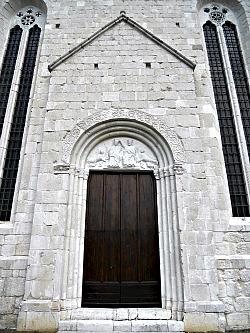
In the wake of the disaster, the remaining structures were restored and reinforced using anti-seismic consolidation methods, while the ruins were rebuilt using the anastylosis technique, which implies the painstaking work of putting the surviving stones back in their original place – like in a giant jigsaw puzzle – while replacing the missing stones with new ones, taken mostly (like the original) from the Tagliamento river bed.
The fabric of the Duomo was started in 1300, but it was not until 1338 that it was consecrated by the Patriarch Bertando di San Geniès. It was constructed in the shape of a truncated Latin cross – basically a T-shape – with a longitudinal nave and a large transept with three apsidal presbyteries and two towers.
In the interior, frescoes dating to the 14th century – which miraculously survived the earthquake – can be admired alongside some notable altarpieces and a 15th century ‘Pietà’ (Vesperbild) from the Salzburg school. The organ, dated 1792, is the work of renowned organ-master Gaetano Callido, and was restored recently (1996; see an atmospheric image of the Duomo’s interior below).
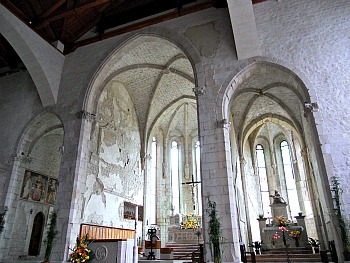
The Mummies of Venzone
Next to the Duomo is the Cappella Cimiteriale di San Michele (“St. Michael’s Cemetery Chapel”), dating to the first half of the 13th century. This interesting little round building was renovated, at last, twenty-five years after the earthquake, and it now houses in its crypt the famous “Mummies of Venzone”.
These ‘mummies’ belong to an age comprised between the 14th and the 19th centuries, and are in fact the remains of ecclesiastical men and women who were placed first in the Cathedral’s crypt, and there became mummified and preserved as a result of natural causes (such as favourable temperature and humidity, and the presence of sulphites in the soil, coupled with the action of a rare parasitic mould). These ‘mummies’ had already achieved a certain popularity in the past – apparently even Napoleon wanted to visit them when the French troops invaded the area in 1797-1807.
The earthquake of 1976 in fact placed in danger also one of these very symbols of Venzone, to which the population had always been very attached to. In 1647 the first mummy to be discovered was called Il Gobbo (the hunchback), which also immediately drew the attention of the soldiers of Napoleon (as in the anecdote mentioned above), who – during the French occupation – cut some strips of flesh from it as a living souvenir.
Since their discovery, the mummies have been the object of curiosity and research. Nowadays, the five mummies are exhibited to the public in the interred floor of San Michele. Thanks to new directions in historical and archaeological sciences, the mummies above all represent a patrimony of priceless anthropological interest that allows us to know comprehensively how the inhabitants of the Friuli of bygone times used to live (below, is a picture of the small round chapel of St. Michael’s Cemetery, where the famous ‘mummies’ are contained; on the background is the Duomo).
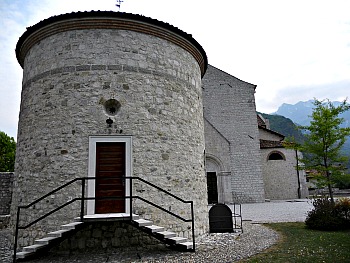
Close by, in the pleasant main square – where there are plenty of open-air cafés for a refreshing stop – is the Municipio (town hall palace), which was built between 1390 and 1410 and is a jewel of Venetian flamboyant Gothic architecture. The exterior of the palace is decorated with the coats of arms of some of the oldest noble families of Venzone, and it is enhanced by five double windows in Venetian Gothic style. The eagle – emblem of the Patriarchs of Aquileia – can be recognized among the other symbols, as well as the embattled bridge, symbol of the town. The corner tower – which houses a chiming 18th century twenty-four hour clock – displays the Lion of St. Mark, which is a reminder of Venzone’s Venetian domination.
The ruins of the Chiesa di San Giovanni Battista (“St. John the Baptist”), which can be seen from the main square, date from the first half of the 14th century, but now only the main façade remains, framed by a Gothic doorway and capitals decorated with figures and floral motifs. This building was left as ruin as a poignant reminder of the ominous events of 1976.
At the other extremity of town, the Porta di San Genesio (San Genesio’s Gateway) can be reached: this is the only archway within the original circle of walls (built in 1309) to have remained intact throughout the centuries. A drawbridge over the moat connected the town centre to the main road, the Via Julia Augusta Altinate.
Many typical buildings in town date to the Renaissance period, and present fascinating courtyards in their interior. Taking the high street northwards, one soon reaches one of such palaces, Palazzo Orgnani-Martina. This 16th century nobleman’s residence is the best preserved – and perhaps the most notable – example of this kind of architecture in Venzone. Past the stone gateway, one first enters the internal courtyard, which was restructured in the 1700s with a stone gallery and an elegant wrought-iron parapet; in the centre there is also a stone fountain.
The Palazzo Orgnani-Martina
Today the Palazzo Orgnani-Martina hosts the town’s most important exhibition space. On the second floor one can visit the permanent display called “Foresta, Uomo, Economia” (‘Forest, Man, Economy’), administered by the park authority (“Ente Parco Prealpi Giulie”; the Julian Alps Regional Park) in association with the local municipality. This exhibition, which aims to show all the aspects related to forest ecosystems, is divided into three sections, each with a different theme. The first section is dedicated to the history and development of the forest; the second concentrates on the fauna, while in the third section the uses and functions of the forest are being investigated.
In more detail, this exhibition constitutes a part of the Museo della Terra di Venzone (“Museum of the Land of Venzone”). In the first hall, a section illustrates the history of the forests through the use of various research methodologies (paleonthology, palynology), written documents and maps. Furthermore, six plastic models explain the evolution of the forest landscapes of the region, from the ice ages to modern times.
The two successive exhibition panels present the main forest typologies of the region, pointing out the most important physionomic traits of the principal species of trees. The last hall holds a section dedicated to the function and uses of the forests, with some educational panels on the circulation of matter and energy, symbiosis, the ecosystems and finally on the physiology of trees, with the aid of an animated panel.
Completing the exhibition is a mycological display with over three hundred types of mushrooms, plus a section dedicated to the forest in fantasy, with representations of characters of the forest from classical, traditional and modern mythology, and a showcase where some questions and quizzes are being posed with the theme of curiosities and specifics related to woods and forests.
Tiere Motus – History of an Earthquake and its People
In this same building is also hosted Tiere Motus – History of an Earthquake and of its People, a comprehensive and moving exhibition that provides a detailed documentation on the ominuos events of the 6th of May and 15th of September 1976, when Venzone, Gemona and other towns in the area were almost razed to the ground by two powerful earthquakes (the second tremor was particularly damaging, as most buildings were already unstable after the first shock).
Hosted on the first floor, this permanent exhbition-workshop aims to preserve and make available to visitors a considerable amount of photographic and documentary heritage (such as videos), as well as documents on the technical, scientific, cultural, legal and social aspects, the survey and and project graphic printouts, and the metodologies of restoration adopted after the 1976 earthquake. Connected to the exhibition and hosted on the ground floor is a hall, appositely set up, which offers a realistic simulation on the shock of the 6th of May, and the collapse of the Duomo. The unusual title assigned to the exhibition marries the expressions of two noble and ancient languages belonging to the history of these lands: the Friulan word tiere (earth) and the latin motus (movement). The word tiere is used here also as a signifier of identity; bearer of profound emotions and of a high sense of belonging to the land and culture of Friuli. Motus is used instead to signify an intense call back to the origins and to an ancient history – but above all to the strenght of the people in overcoming two millennia of human events and hostile natural occurrences.
The workshop-exhibition begins with a hall dedicated to a graphical 3-D simulation of the collpase of Venzone’s Duomo on the night of the 6th of May. One section is also dedicated to the bestowing of the Medaglia d’Oro al Merito Civile (Gold Medal for Civil Merit) by the head of State to the Gonfaloni (Gonfalons) of the Region and to the 45 municipalities destroyed or heavily affected by the earthquake. Finally, on the “Wall of Memory” the visitor can freely contribute their testimony.
Other Events and Things to Do in Venzone
A number of events are organized throughout the year in Venzone. The most popular, every October, is perhaps the “Festa della Zucca” (‘Pumpkin Festival’) – a medieval fair in which the whole town takes part in a historical re-enactment. At this time, many dishes that have pumpkin as their main ingredient can be savoured. A yearly summer festival, from June to September, takes performance and musical events to the streets; there are also a number of modern art exhibitions, as well as theatre representations in Friulano – the ancient (but still spoken) language of Friuli.
Other events include two summer fairs (“Sagra di San Giacomo e Anna” in July; “Sagra di San Bartolomeo” in August) and one in winter (“Sagra di Santa Lucia”), as well as an international organ recital, which takes place every September within the atmospheric setting of the Duomo (but other concerts and recitals also make use of this almost magical space throughout the year).
As a note of curiosity, in Venzone and its surroundings were also filmed a few scenes of “A Farewell to Arms” and “La Grande Guerra” (by Mario Monicelli) – thus underlying the connection that this area traditionally always had with war and soldiers (there is still an important barrack of the ‘Alpini’ troops here – the Italian mountaineering regiment).
In terms of nature, the woods and the mountains around Venzone are rich in wild fauna, and the protected area within its territory (the “Parco Prealpi Giulie” – Julian Alps Regional Park) is one of the few in the Alps where all the main carnivores of this huge mountian range – apart from wolf – (lynx, bear) can still be found.
Return from Venzone to Italy-Tours-in-Nature
Copyright © 2012 Italy-Tours-in-Nature

New! Comments
Have your say about what you just read! Leave me a comment in the box below.